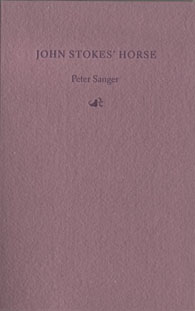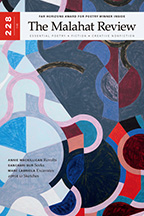Reviews
Poetry Review by David Goldstein:
Leaping Beauty of Peter Sanger's New Poems

Peter Sanger, John Stokes' Horse (Kentville: Gaspereau, 2012). Paperbound, 123 pp.
John Stokes’ Horse, the ninth collection of poetry by the Nova Scotia writer, Peter Sanger, is haunted by the modest things that compose the world. From the first poem, which asks
how do you like
this air
on
a flute
worth a sou
to the book’s phenomenal closing essay, “Leaping Time,” chronicling the lonely occupations of an isolated boy, this book concerns itself with the small, the overlooked, the objects we take in “at a glance.” In short lines that work the distance between accentual and free verse, laid down like two-by-fours or railway tracks, Sanger travels a landscape of intimate events. Gaspereau Press has bound the whole in a handsome physical volume, with letterpress cover and luxurious cotton paper, that bespeaks the careful, handmade ethos that also permeates the poems.

Many are quietly droll. In “Rhubarb,” the speaker admires the plant’s “local tumescence / at well-managed feasts” and its ability “to set teeth / on edge in a frisson / of fastidious hauteur,” The poem “Sea Horse” imagines how “enviable” a career the male of the species, which carries the female’s eggs, would have achieved had it forsaken the sea for dry land. But Sanger’s humour is tempered by advice he received from Richard Outram (which appears uncredited in the title poem, but which Sanger paraphrased in a 2012 interview with rob mclennan): “a poem must carry / some measure of grief.” Indeed, each of these poems feels as if it’s measuring a loss—often the disappearance of some mutely beautiful moment or the failure of language to capture such a moment. For the Indian pipe, the tiny plant known for growing on corpses, “there’s no turning back / turning back.”
The title poem, which takes up a third of the book, elaborates upon these themes. A 35-part fantasia on an aquatint by Newfoundland artist David Blackwood, based in turn on a toy horse Blackwood discovered in a Wesleyville museum, “John Stokes’ Horse” hunkers down in the music of description, singing about “the flicker of muscles, / flexing its skin, / scattering deer flies.” But like Elizabeth Bishop, another master of description and a poet about whom Sanger has written, description never constitutes an end in itself. Sanger’s toy horse opens onto a prospect of interlocked meditations about childhood imagination, with its Orientalist stories of Arabian horses, its myths and fairy tales, its songs and primal rhythms. When children grow up and become poets, this ground of imagination becomes mixed with sterner stuff—Shakespeare, Yeats, and above all, the long tradition of associating poetry with horses, dating back in English at least to Philip Sidney’s Defense of Poetry. The poem thinks carefully about how childhood obsessions, adult language, and the symbiotic energy of horseback riding can start to suggest a poetics:
O, I’d ride such a canter of words
until they and my horse
were one
pond, frog, splash.
The poem, and the book, become an attempt to figure out how to use poetry to accept “life as it comes, / in whatever / whittled way.”
Good poets worry, and what they worry most about is how to get the world into language. “The last time I looked,” writes Sanger of the lowly shrub Artemisia, “you resisted / all metaphor.” A major concern of John Stokes’ Horse is to reanimate the drama of description—to ask why and how we describe things as we do. Many of the poems attempt to eschew metaphor and simplistic sorts of descriptive analogy. “Nothing is like,” maintains the speaker of “November Blossom.” Interestingly, many of the poems rely upon second-person imperatives, perhaps as a way to resist easy descriptions: “Lift it up.” “Take a lantern.” “Ask me, love, what we’ve / been given.” “Beg me / a dollar for Charon.” The poet constantly exhorts the reader not to watch, but to do. Inhabit the poem. Fulfill it. Ultimately Sanger seems interested in a poetic saying that is
Not mimesis, but moments
the world is beside itself,
the dove whose call
is elsewhere and here.
(“John Stokes’ Horse”)
He seeks a poetry of instants, where the mind and the immanent world can share, briefly, an understanding.
Despite Sanger’s ambivalence, metaphor does creep in, and its presence is not always salutary. Moments of weakness in the book often have to do with a simile too easily grasped, or a stock rhythm not sufficiently questioned. Poets must constantly stand by the gate like Macbeth’s porter, demanding that every piece of language justify itself before entering.
Among the subtle constructions of John Stokes’ Horse, some lesser lines have found their way through. Is “The Green Prince” really as “phosphorescent / as plankton”? Few plankton are phosphorescent; one assumes that “bioluminescent plankton” felt too clunky and was edited, but in a way that causes the phrase to thud. Line breaks sometimes feel rote, as if made more for the look of the poem than to build tension. Is “Against death dressed in black” the freshest possible refrain to use in the otherwise delicate elegy “Gardener”? And in a book about the difficult beauty of small things, some lines seem a bit too in love with their own lyricism—in “Four Cups,” the phrase “scarves / of cerise” floats cavalierly through, almost stealing the show.
In a sense, the work is a victim of its own success. The book’s style is so assured, so artful, that it sometimes feels restrictive; one wants the poems to break out and experiment with other expressive possibilities, other sounds. In this regard, the most intriguing poem is “Civics,” an attack on current Canadian political culture that incorporates surprising uses of found language while announcing wittily, “This is the great Canadian / monotone.” And sometimes the analogies are startlingly right, as in the gorgeous “Fragments of Wall,” comparing an abandoned wall in Nova Scotia with the much more famous one in Berlin. Here the poet considers a spray-painted “fraise” on the Canadian wall as a kind of depraved echo of the German “frei,” a gesture that has lost all political meaning and yet can still be a site of beauty.
At their best, the poems of John Stokes’ Horse make beauty happen, which is often all we deserve to ask of the written word.

David Goldstein
* * * * * * * *
David B. Goldstein's first poetry book, Laws of Rest, will be published by BookThug in October. His poems have appeared in journals and anthologies throughout North America, including The Malahat Review, The Paris Review, filling Station, CV2, Epoch, Harp & Altar, Jubilat, 6x6, and Octopus. He is an active literary critic, food writer, and translator; his first scholarly book, Eating and Ethics in Shakespeare's England, also comes out this fall. Goldstein lives with his family in Toronto, where he teaches English and directs the Creative Writing Program at York University.









